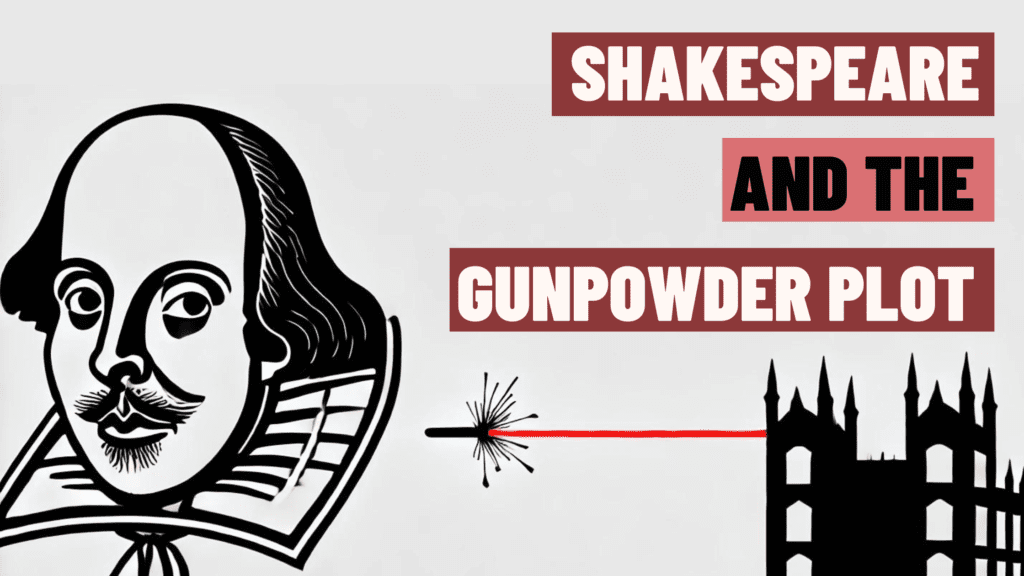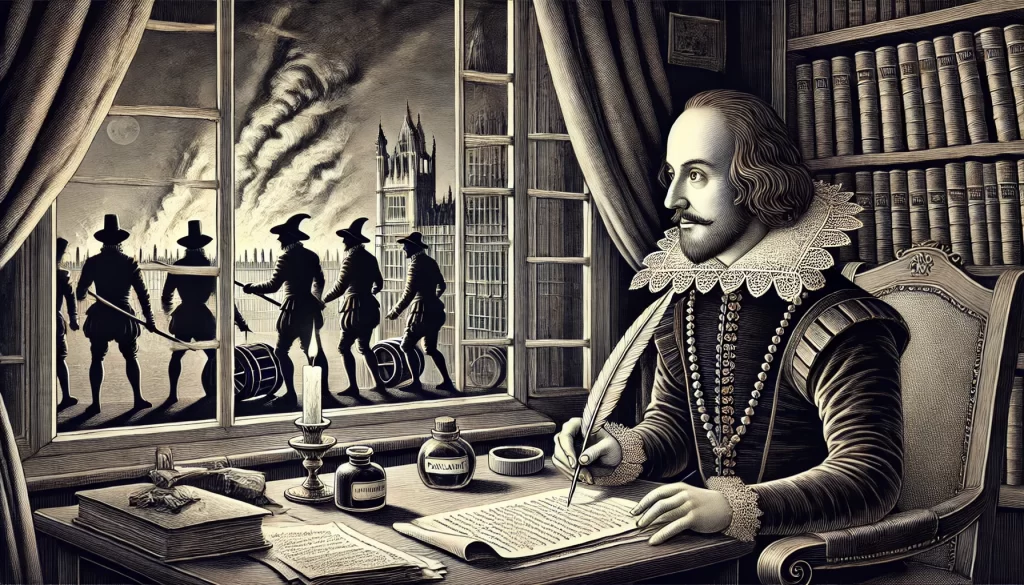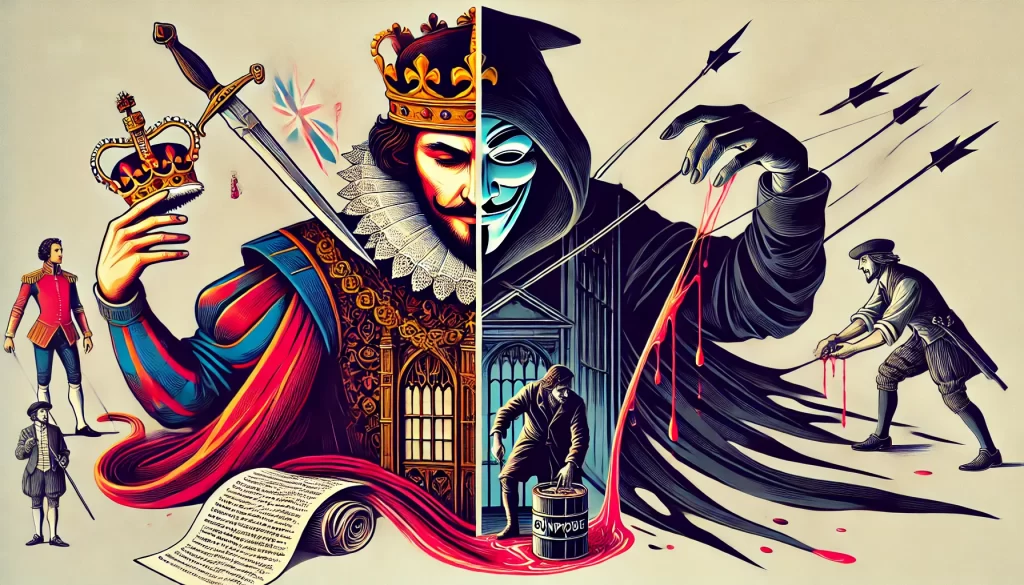It can be a struggle to make Shakespeare’s plays feel relevant and engaging to our students. One powerful way to bridge this gap is by connecting the Bard’s works to their historical context. In this post, we’ll explore how teaching Macbeth alongside the infamous Gunpowder Plot of 1605 can deepen students’ understanding and appreciation of Shakespeare’s craft.

Table of Contents
The Gunpowder Plot: Shakespeare’s Real-Life Inspiration
Many students (and even some teachers) might not realize that Macbeth was inspired by real-life events. Shakespeare essentially turned a 17th-century terrorist attack into the world’s first political thriller. The Gunpowder Plot of 1605 was a failed attempt by a group of English Catholics to assassinate King James I by blowing up the House of Lords during the State Opening of Parliament. Knowing this historical context has changed the way I teach Macbeth.
This historical context provides a fascinating backdrop for studying Macbeth. It allows us to explore themes of political power, betrayal, and the consequences of ambition in a way that feels more tangible and relatable to students.

Bringing History to Life in the Classroom
So, how can we effectively incorporate this historical context into our teaching of Macbeth? Here are some strategies I’m excited about:
1. Create a Narrative Arc
One approach I’ve used is to create a fictional account of Shakespeare writing Macbeth, incorporating historical context throughout. I’ve used AI to generate a series of five “episodes,” one for each act of the play, that imagine Shakespeare’s writing process and the political atmosphere of the time.
This narrative approach helps students understand the connections between the play and its historical context in a more engaging way than a simple lecture. It also provides an opportunity to discuss the use of AI in education and creative writing, adding another layer of relevance for tech-savvy students.

2. Explore the Language of Equivocation
The Gunpowder Plot provides an excellent entry point for discussing the concept of equivocation – a key thematic concept in Macbeth. Equivocation refers to the use of ambiguous language to conceal the truth while avoiding outright lying.
During the trials of the Gunpowder Plot conspirators, the concept of equivocation became a hot topic. The Jesuit priest Henry Garnet, who was executed for his alleged role in the plot, wrote a treatise defending the use of equivocation in certain circumstances.
In Macbeth, we see this concept play out in the witches’ prophecies and in Macbeth’s own language as he descends into tyranny. By connecting this to the real-life debates happening in Shakespeare’s time, we can help students understand the power and danger of manipulative language – a lesson that remains highly relevant today.
3. Comparative Analysis
Have students compare and contrast the real-life Gunpowder Plot with the events of Macbeth. This can be done through:
- Venn diagrams comparing the motivations and actions of the conspirators with those of Macbeth
- Timeline activities that place events from the play alongside real historical events
- Character studies comparing Macbeth to key figures in the Gunpowder Plot
This type of analysis encourages critical thinking and helps students see how Shakespeare transformed historical events into compelling drama.

4. Modern Parallels
While the Gunpowder Plot occurred over 400 years ago, its themes of political unrest, conspiracy, and the struggle for power are still relevant today. Encourage students to find modern parallels to both the Gunpowder Plot and Macbeth. This could involve:
- Researching modern political scandals or coup attempts
- Analyzing how social media and 24-hour news cycles have changed the nature of political intrigue
- Discussing the role of “fake news” and misinformation in modern politics, connecting it back to the theme of equivocation
These connections can help students see the timeless nature of Shakespeare’s themes and the continuing relevance of studying historical events.
5. Creative Projects
To really bring the historical context to life, consider assigning creative projects that blend the world of Macbeth with the reality of the Gunpowder Plot. Some ideas include:
- Writing newspaper articles reporting on events from the play as if they were happening alongside the Gunpowder Plot
- Creating social media profiles for characters from Macbeth, incorporating both events from the play and reactions to the Gunpowder Plot
- Designing propaganda posters either supporting or condemning Macbeth’s actions, using language and imagery reminiscent of the political climate of 1605
These projects not only reinforce students’ understanding of both the play and its historical context but also allow for creative expression and the development of media literacy skills.

The Power of Historical Context
By teaching Macbeth alongside the Gunpowder Plot, we’re doing more than just providing interesting historical tidbits. We’re showing students how literature responds to and shapes the world around it. We’re demonstrating Shakespeare’s genius in transforming current events into timeless art. And perhaps most importantly, we’re helping students see that the themes Shakespeare grappled with – ambition, loyalty, the corrupting influence of power – are just as relevant today as they were four centuries ago.
This approach also helps develop critical thinking skills. Students learn to:
- Analyze how historical events influence art and literature
- Recognize the ways in which writers respond to and comment on their political and social environment
- Draw connections between past and present, seeing how history can inform our understanding of current events
Moreover, this historical approach can make Shakespeare feel more accessible. Instead of a remote figure writing in impenetrable language, students can begin to see Shakespeare as a man responding to the tumultuous events of his time – not unlike how they might respond to events in their own lives through social media posts or creative projects.
Conclusion
Teaching Shakespeare doesn’t have to be a slog through antiquated language and seemingly irrelevant plots. By connecting his works to their historical context – in this case, linking Macbeth to the Gunpowder Plot – we can breathe new life into these classic plays. We can help our students see Shakespeare as a vibrant, politically engaged writer whose works still have much to teach us about power, ambition, and the human condition.
So the next time you’re preparing to teach Macbeth, don’t just focus on the witches and the famous “out, damned spot” scene. Take some time to explore the Gunpowder Plot and watch as your students discover a Shakespeare who’s far more exciting – and relevant – than they ever imagined.

It’s a crucial enquiry, to examine what Shakespeare’s attitude might have been to the Gunpowder Plot. However, I don’t think that ‘Macbeth’ is a fitting parallel. You say that both stories concern political unrest, conspiracy and the struggle for power; however, Macbeth – when we first meet him – is a renowned, celebrated warrior – honourable, faithful and loyal to his king. It’s only via the catalyst of the witches’ prophecy and the machinations of his wife that he has a ‘vaulting ambition’ thrust upon him. He is no Catesby, who was persecuted by the regime of Elizabeth along with his whole family, and who was implicit in harbouring a high-ranking Jesuit priest who had been sent over to England in an attempt to undermine the people’s support for the Queen. Macbeth has the insidious flame of ambition lit within him despite himself – which gradually overcomes and destroys him; whereas within Catesby there was a smouldering hatred from the beginning, which became hotter as he reacted to the outrageous constraints, impediments and crippling fines meted out against the ‘recusant’ Catholics of his time. Macbeth is the truly ‘tragic’ figure, because his fate involves a fall from grace and respect through the growth of a latent ambition (his ‘hamartia’, in Aristotle’s sense) initiated by external forces; whereas with Catesby there is the irrepressible growth of anger and a desire for retribution and revenge which has naturally built up over years of persecution. Catesby is not tragic – he simply fails to achieve his very ambitious aim; if he had succeeded, then many would have praised him as a saviour, and he would have risen to high office and probably stayed there.
I don’t disagree with your reading and analysis, but I’m not drawing a straight line between Macbeth and Catesby.
I think it’s so interesting that there are multiple battles going on at the beginning of the play, and the line “What he hath lost, noble Macbeth hath gained” always makes me pause – because what Macbeth gains is the title of a traitorous thane, which Macbeth then becomes. The political unrest in my opinion is not with Macbeth, but with others around him. Also putting Macbeth into historical perspective (the reign of Macbeth, not Shakespeare) puts an interesting layer on the play. So there is the struggle for power of others in the opening of the play.
Also the struggle for power is not really with Macbeth either, it’s Lady Macbeth. When looking at both Shakespeare’s time and the historical Macbeth, again, there are interesting ideas to explore. Lady Macbeth is fighting under “her battlements” – which is such an interesting word for Lady Macbeth to use – her battle is within the castle, which she is confined to.
And then there is certainly political unrest when Macbeth becomes king, as evidence by Malcolm’s speech.
And Shakespeare certainly shows that Macbeth is not the rightful king, but there is also conspiracy to usurp him from his throne. One of the details I explain to my students is using the lens of the historical Macbeth, it would have been reasonable for Macbeth to think that he could reasonably become king as one of the greatest warriors, and Lady Macbeth’s references to a before-time seem to suggest that Macbeth’s ambitious may have not been so latent. But, that is one of the many ambiguities of the play.